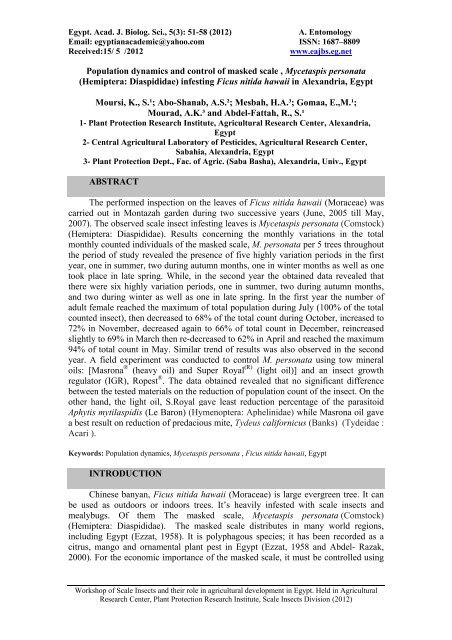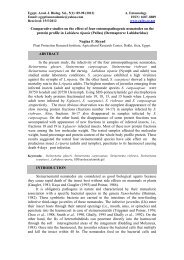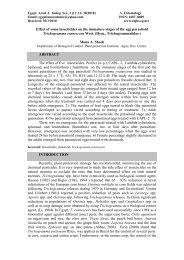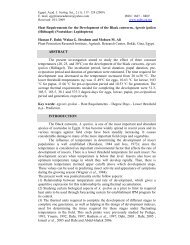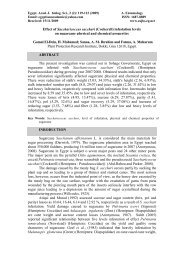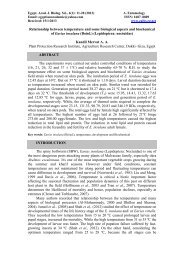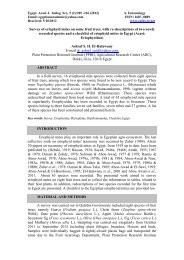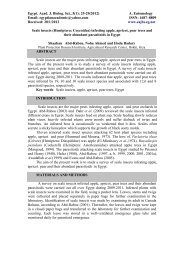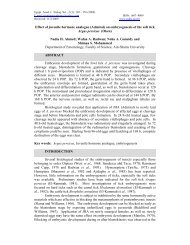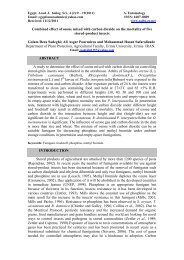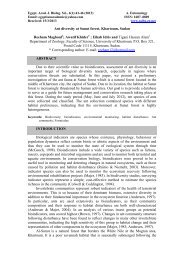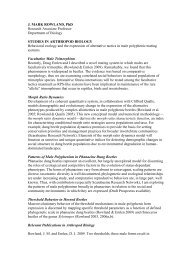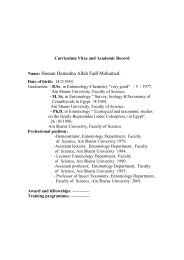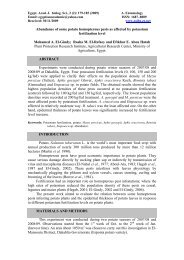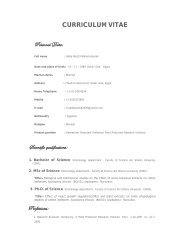(Hemiptera: Diaspididae) infesting Ficus nitida hawaii in
(Hemiptera: Diaspididae) infesting Ficus nitida hawaii in
(Hemiptera: Diaspididae) infesting Ficus nitida hawaii in
Create successful ePaper yourself
Turn your PDF publications into a flip-book with our unique Google optimized e-Paper software.
Egypt. Acad. J. Biolog. Sci., 5(3): 51-58 (2012) A. Entomology<br />
Email: egyptianacademic@yahoo.com ISSN: 1687–8809<br />
Received:15/ 5 /2012 www.eajbs.eg.net<br />
Population dynamics and control of masked scale , Mycetaspis personata<br />
(<strong>Hemiptera</strong>: <strong>Diaspididae</strong>) <strong><strong>in</strong>fest<strong>in</strong>g</strong> <strong>Ficus</strong> <strong>nitida</strong> <strong>hawaii</strong> <strong>in</strong> Alexandria, Egypt<br />
Moursi, K., S.¹; Abo-Shanab, A.S.²; Mesbah, H.A.³; Gomaa, E.,M.¹;<br />
Mourad, A.K.³ and Abdel-Fattah, R., S.¹<br />
1- Plant Protection Research Institute, Agricultural Research Center, Alexandria,<br />
Egypt<br />
2- Central Agricultural Laboratory of Pesticides, Agricultural Research Center,<br />
Sabahia, Alexandria, Egypt<br />
3- Plant Protection Dept., Fac. of Agric. (Saba Basha), Alexandria, Univ., Egypt<br />
ABSTRACT<br />
The performed <strong>in</strong>spection on the leaves of <strong>Ficus</strong> <strong>nitida</strong> <strong>hawaii</strong> (Moraceae) was<br />
carried out <strong>in</strong> Montazah garden dur<strong>in</strong>g two successive years (June, 2005 till May,<br />
2007). The observed scale <strong>in</strong>sect <strong><strong>in</strong>fest<strong>in</strong>g</strong> leaves is Mycetaspis personata (Comstock)<br />
(<strong>Hemiptera</strong>: <strong>Diaspididae</strong>). Results concern<strong>in</strong>g the monthly variations <strong>in</strong> the total<br />
monthly counted <strong>in</strong>dividuals of the masked scale, M. personata per 5 trees throughout<br />
the period of study revealed the presence of five highly variation periods <strong>in</strong> the first<br />
year, one <strong>in</strong> summer, two dur<strong>in</strong>g autumn months, one <strong>in</strong> w<strong>in</strong>ter months as well as one<br />
took place <strong>in</strong> late spr<strong>in</strong>g. While, <strong>in</strong> the second year the obta<strong>in</strong>ed data revealed that<br />
there were six highly variation periods, one <strong>in</strong> summer, two dur<strong>in</strong>g autumn months,<br />
and two dur<strong>in</strong>g w<strong>in</strong>ter as well as one <strong>in</strong> late spr<strong>in</strong>g. In the first year the number of<br />
adult female reached the maximum of total population dur<strong>in</strong>g July (100% of the total<br />
counted <strong>in</strong>sect), then decreased to 68% of the total count dur<strong>in</strong>g October, <strong>in</strong>creased to<br />
72% <strong>in</strong> November, decreased aga<strong>in</strong> to 66% of total count <strong>in</strong> December, re<strong>in</strong>creased<br />
slightly to 69% <strong>in</strong> March then re-decreased to 62% <strong>in</strong> April and reached the maximum<br />
94% of total count <strong>in</strong> May. Similar trend of results was also observed <strong>in</strong> the second<br />
year. A field experiment was conducted to control M. personata us<strong>in</strong>g tow m<strong>in</strong>eral<br />
oils: [Masrona ® (heavy oil) and Super Royal (R) (light oil)] and an <strong>in</strong>sect growth<br />
regulator (IGR), Ropest ® . The data obta<strong>in</strong>ed revealed that no significant difference<br />
between the tested materials on the reduction of population count of the <strong>in</strong>sect. On the<br />
other hand, the light oil, S.Royal gave least reduction percentage of the parasitoid<br />
Aphytis mytilaspidis (Le Baron) (Hymenoptera: Aphel<strong>in</strong>idae) while Masrona oil gave<br />
a best result on reduction of predacious mite, Tydeus californicus (Banks) (Tydeidae :<br />
Acari ).<br />
Keywords: Population dynamics, Mycetaspis personata , <strong>Ficus</strong> <strong>nitida</strong> <strong>hawaii</strong>, Egypt<br />
INTRODUCTION<br />
Ch<strong>in</strong>ese banyan, <strong>Ficus</strong> <strong>nitida</strong> <strong>hawaii</strong> (Moraceae) is large evergreen tree. It can<br />
be used as outdoors or <strong>in</strong>doors trees. It’s heavily <strong>in</strong>fested with scale <strong>in</strong>sects and<br />
mealybugs. Of them The masked scale, Mycetaspis personata (Comstock)<br />
(<strong>Hemiptera</strong>: <strong>Diaspididae</strong>). The masked scale distributes <strong>in</strong> many world regions,<br />
<strong>in</strong>clud<strong>in</strong>g Egypt (Ezzat, 1958). It is polyphagous species; it has been recorded as a<br />
citrus, mango and ornamental plant pest <strong>in</strong> Egypt (Ezzat, 1958 and Abdel- Razak,<br />
2000). For the economic importance of the masked scale, it must be controlled us<strong>in</strong>g<br />
Workshop of Scale Insects and their role <strong>in</strong> agricultural development <strong>in</strong> Egypt. Held <strong>in</strong> Agricultural<br />
Research Center, Plant Protection Research Institute, Scale Insects Division (2012)
52<br />
Moursi, K., S. et al.<br />
an alternative effective and relatively environmental safe scalicides such as IGR,s and<br />
m<strong>in</strong>eral oils (MARL, 1997 and Abo-Shanab,2005).<br />
The present work aimed to add some ecological notes on this coccoid species on<br />
one of the important ornamental tree <strong>in</strong> public and private gardens. Also, the study<br />
aimed to evaluate the efficacy of two local m<strong>in</strong>eral oils (heavy and light) and an IGR<br />
for controll<strong>in</strong>g the masked scale.<br />
MATERIALS AND METHODS<br />
1. Ecological study:<br />
Survey and <strong>in</strong>spection were started from March 2005 till February 2007 <strong>in</strong><br />
Montazah public gardens <strong>in</strong> Alexandria Governorate. The trees were not exposed to<br />
any pesticides treatments dur<strong>in</strong>g the period of study. Five trees were randomly chosen<br />
to the survey of the scale <strong>in</strong>sect. Ten leaves were monthly picked out at random, from<br />
each direction of <strong>in</strong>spected tree. Leaves were put <strong>in</strong> cloth bags; transported<br />
immediately to the laboratory for classify<strong>in</strong>g and count<strong>in</strong>g the exist<strong>in</strong>g <strong>in</strong>dividuals of<br />
detected species us<strong>in</strong>g a stereoscopic b<strong>in</strong>ocular microscope. The upper and lower<br />
surfaces of the leaves were carefully exam<strong>in</strong>ed. The rate of <strong>in</strong>crease/decrease <strong>in</strong><br />
population densities was calculated by divid<strong>in</strong>g the mean number of <strong>in</strong>sects found <strong>in</strong><br />
the sample over that found <strong>in</strong> preced<strong>in</strong>g one (Bodenheimer, 1951).<br />
2. Chemical study:<br />
A field experiment was carried out <strong>in</strong> August, 2008 <strong>in</strong> Mountazah garden.<br />
Three treatments were used as well as control, replicated five times, were randomly<br />
districted over 20 trees. The tested scalicides were two local m<strong>in</strong>eral oils namely<br />
Masrona oil ® (heavy oil) [85% mayonnaise, produced by Misr Petroleum Co.] and<br />
Super Royal oil ® (light oil) [95% E.C, produced by El-Gameia El-Taawnia for<br />
Petroleum Co.] and one IGR called Ropest ® [produced by Shoura Chemicals, Co.] at<br />
concentrations of 2.5%, 1.5% and 0.125%, respectively. Pre-treatment count was<br />
made before spray and four post counts were made after 2, 4, 6, and 8 weeks after<br />
spray. The liv<strong>in</strong>g scales were exam<strong>in</strong>ed on 10 leaves from each tree. To evaluate the<br />
efficacy of the tested materials, the percentage of reduction was determ<strong>in</strong>ed accord<strong>in</strong>g<br />
to Stafford and Summers (1963) for scale <strong>in</strong>sect and Henderson and Tilton (1955) for<br />
parasitoid and predacious mite. In an effort to estimate the distribution and population<br />
densities of the detected scale <strong>in</strong>sect, the obta<strong>in</strong>ed results were statistically analyzed<br />
accord<strong>in</strong>g to (Snedecor, 1970).<br />
RESULTS AND DISCUSSION<br />
1. Ecological study:<br />
Data <strong>in</strong> Table (1) and Fig. (1) show the calculated monthly variations <strong>in</strong><br />
population density of the masked scale, M. personata <strong><strong>in</strong>fest<strong>in</strong>g</strong> F. <strong>nitida</strong> <strong>hawaii</strong> <strong>in</strong><br />
Montazah gardens dur<strong>in</strong>g the period of study. It is revealed that the relatively low<br />
total number of <strong>in</strong>sects/5trees <strong>in</strong> July month (357) <strong>in</strong>creased gradually to reach 1343<br />
<strong>in</strong>dividuals/5trees <strong>in</strong> September; represented 14.4% of the total collected <strong>in</strong>sect/year<br />
<strong>in</strong> September 2005, then decreased up to 511 <strong>in</strong>dividuals per 5trees represent<strong>in</strong>g 5.5%<br />
of total count/year <strong>in</strong> January, 2006, re-<strong>in</strong>creased aga<strong>in</strong> to reach 1215 <strong>in</strong>dividuals/tree<br />
and represented 13% of total count per year <strong>in</strong> February, 2006, then started to<br />
decrease aga<strong>in</strong> to reach 542 <strong>in</strong>dividuals/tree resembl<strong>in</strong>g 5.8% of total count/year <strong>in</strong><br />
April and so on re- <strong>in</strong>creased dur<strong>in</strong>g May to reach 868 <strong>in</strong>dividuals/tree (9.3% of total
Population dynamics and control of masked scale , Mycetaspis personata<br />
count ) to start another decrease <strong>in</strong> June and July of the next year (Table, 1 and Fig.<br />
1).<br />
Table 1: Monthly variations <strong>in</strong> population count of Mycetaspis personata <strong><strong>in</strong>fest<strong>in</strong>g</strong> <strong>Ficus</strong> <strong>nitida</strong> <strong>hawaii</strong><br />
dur<strong>in</strong>g 2005-2006 and 2006-2007 <strong>in</strong> Alexandria Governorate.<br />
Months<br />
Total count/5trees<br />
Quotient of<br />
<strong>in</strong>crease<br />
% of grand total<br />
count/year<br />
% of <strong>in</strong>spected<br />
Females<br />
% of <strong>in</strong>spected<br />
Males<br />
05-06 06-07 05-06 06-07 05-06 06-07 05-06 06-07 05-06 06-07<br />
June, 482 415 - - 5.3 5.2 92.0 88.0 8.0 12.0<br />
July 357 100 0.74 0.24 3.8 1.2 100.0 100.0 0.0 0.0<br />
August 715 799 2.00 8.00 7.6 9.9 86.2 91.0 14.0 9.0<br />
September 1343 559 1.88 0.70 14.4 6.9 72.0 72.0 28.0 28.0<br />
October 854 610 0.64 1.09 9.2 7.6 68.0 75.0 32.0 25.0<br />
November 856 763 1.00 1.25 9.2 9.5 72.0 74.0 28.0 26.0<br />
December 711 973 0.83 1028 7.6 12.1 66.0 58.0 34.0 42.0<br />
January 511 594 0.72 0.61 5.5 7.4 67.0 75.0 33.0 25.0<br />
February 1215 1052 2.38 1.77 13.0 13.1 68.0 65.0 32.0 35.0<br />
March 863 734 0.71 0.70 9.3 9.1 69.0 64.0 31.0 36.0<br />
April 542 462 0.63 0.63 5.8 5.7 62.0 62.0 38.0 38.0<br />
May 868 989 1.60 2.14 9.3 12.3 94.0 90.0 6.0 10.0<br />
Grand<br />
total/year<br />
9317 8050 % of grand total count/year 76.3 76.2 23.7 23.8<br />
Fig. 1: Percentage monthly variations of total count of Mycetaspis personata <strong>in</strong>fested <strong>Ficus</strong> <strong>nitida</strong><br />
<strong>hawaii</strong> dur<strong>in</strong>g (2005-2006 and 2006-2007) <strong>in</strong> Alexandria Governorate<br />
Here<strong>in</strong>, <strong>in</strong> the second year (June 2006, May 2007) the data showed similar trend<br />
of results but with slight difference, where the first high number of <strong>in</strong>sects was<br />
recorded <strong>in</strong> August (799 <strong>in</strong>dividuals/5trees represent<strong>in</strong>g 9.9% of grand total<br />
count/year). The second peak of <strong>in</strong>creased <strong>in</strong>sects was recorded <strong>in</strong> December (973<br />
<strong>in</strong>dividuals/5trees represent<strong>in</strong>g 12.1% of total count/year), then that highest number<br />
decreased up to 594 <strong>in</strong>dividuals/5trees (7.4% of total count/year) <strong>in</strong> January, re<strong>in</strong>creased<br />
aga<strong>in</strong> to a maximum of 1052 <strong>in</strong>dividuals/5trees (13.1% of total count ) <strong>in</strong><br />
February; further re-decreased up to 462 <strong>in</strong>sect/5trees <strong>in</strong> April, to give another<br />
<strong>in</strong>crease comprised 989 <strong>in</strong>dividuals/5trees (12.3% of total count/year) <strong>in</strong> May, 2007<br />
(Table 1 and Fig. 1); followed by a start of decrease <strong>in</strong> June & July of the next year.<br />
Moreover, the drastic effect of Khamas<strong>in</strong> hot w<strong>in</strong>ds was reflected also on the<br />
relatively lower number of total counted <strong>in</strong>dividuals/5trees <strong>in</strong> April month of both<br />
years.<br />
Results concern<strong>in</strong>g the monthly variations (Quotient of <strong>in</strong>crease, Q.I.) <strong>in</strong> the<br />
total monthly counted <strong>in</strong>dividuals of the masked scale, M. personata per 5 trees<br />
throughout the period of study revealed the presence of five highly variation periods<br />
<strong>in</strong> the first year, one <strong>in</strong> summer (2.0), two dur<strong>in</strong>g autumn months (1.88 & 1.0) one <strong>in</strong><br />
w<strong>in</strong>ter months (2.38) as well as another one detected <strong>in</strong> late spr<strong>in</strong>g (1.60) (Table1). In<br />
53
54<br />
Moursi, K., S. et al.<br />
the second year, the obta<strong>in</strong>ed data revealed that also there were six highly variation<br />
periods, one <strong>in</strong> summer (8.0), two dur<strong>in</strong>g autumn months (1.09 & 1.25), two dur<strong>in</strong>g<br />
w<strong>in</strong>ter (1.28 and 1.77) as well as one <strong>in</strong> late spr<strong>in</strong>g (2.14), (Table, 1). The exhibited<br />
results <strong>in</strong> (Table, 1 and Fig.2) showed that the estimated density values of the adult<br />
females of M. personata on F. <strong>nitida</strong> <strong>hawaii</strong> leaves. Whereas <strong>in</strong> the first year the<br />
calculated percentage of adult female reached the maximum of total population dur<strong>in</strong>g<br />
July.<br />
% of female and / or male<br />
120<br />
100<br />
80<br />
60<br />
40<br />
20<br />
0<br />
Female 05-06 Female 06-07<br />
Male 05-06 Male 06-07<br />
Months<br />
Fig. 2: Monthly calculated percentage of <strong>in</strong>spected females and males of Mycetaspis personata<br />
<strong><strong>in</strong>fest<strong>in</strong>g</strong> <strong>Ficus</strong> <strong>nitida</strong> <strong>hawaii</strong> dur<strong>in</strong>g 2005-2006 and 2006-2007 <strong>in</strong> Alexandria Governorate<br />
(100% of the monthly total counted <strong>in</strong>sects); then decreased to 68% of the total<br />
count dur<strong>in</strong>g October, <strong>in</strong>creased to 72% <strong>in</strong> November, decreased aga<strong>in</strong> to 66% of total<br />
count <strong>in</strong> December, re-<strong>in</strong>creased slightly to 69% <strong>in</strong> March then re-decreased to 62%<br />
<strong>in</strong> April and reached the maximum 94% of total count <strong>in</strong> May (Table 1). Similar<br />
trend of results was also observed <strong>in</strong> the second year (June, 2006-May, 2007), dur<strong>in</strong>g<br />
which the population of M. personata adult females reached 100% of total count<br />
dur<strong>in</strong>g July, then decreased to reach 58% of the total counted <strong>in</strong>sect dur<strong>in</strong>g December,<br />
re-<strong>in</strong>creased aga<strong>in</strong> to 75% <strong>in</strong> January, then re-decreased to 62% <strong>in</strong> April and reached<br />
highly percentage compris<strong>in</strong>g 90% of the total count dur<strong>in</strong>g May, 2007 (Table 1 and<br />
Fig.2). Concern<strong>in</strong>g the measured population density of adult males, their detected<br />
numbers were less than those of adult females throughout the year. By beg<strong>in</strong>n<strong>in</strong>g of<br />
summer months, the adult male of M. personata represented 8% of the total monthly<br />
counted <strong>in</strong>sects; disappeared completely dur<strong>in</strong>g July. Later, the calculated percentage<br />
of adult male dur<strong>in</strong>g August represented 14% of total counted <strong>in</strong>dividuals/month;<br />
followed <strong>in</strong>crease to reach 32% dur<strong>in</strong>g October, then decreased to 28% dur<strong>in</strong>g<br />
November; re <strong>in</strong>creased to 34% <strong>in</strong> December, then followed by decreased densities<br />
dur<strong>in</strong>g January, February and March and <strong>in</strong>creased aga<strong>in</strong> to reach the maximum (38%<br />
of total count) <strong>in</strong> April <strong>in</strong> the first year of study (Table 1). The same trend of results<br />
has been obta<strong>in</strong>ed dur<strong>in</strong>g the second year with a slight difference <strong>in</strong> the percentage of<br />
total count (Table1). These results are <strong>in</strong> agreement with the f<strong>in</strong>d<strong>in</strong>gs of Abdel Razak<br />
(2000) and Mesbah et al. (2003) who mentioned that the population of adult males of<br />
M. personata on F. <strong>nitida</strong> <strong>in</strong>creased dur<strong>in</strong>g October and reached high percentage<br />
dur<strong>in</strong>g w<strong>in</strong>ter and spr<strong>in</strong>g months. The seasonal variation <strong>in</strong> population density of<br />
occurr<strong>in</strong>g M. personata <strong>in</strong>dividuals on F. <strong>nitida</strong> <strong>hawaii</strong> are shown <strong>in</strong> (Fig.3). The data<br />
revealed that the highest population density of collected <strong>in</strong>dividuals was observed<br />
dur<strong>in</strong>g autumn months <strong>in</strong> the first year; comprised 3053 <strong>in</strong>dividuals that represent<br />
32.7 % of grand total count per year; while <strong>in</strong> the second year the highest population
Population dynamics and control of masked scale , Mycetaspis personata<br />
was recorded dur<strong>in</strong>g w<strong>in</strong>ter months with a total count of 2619 <strong>in</strong>dividuals that<br />
represent 32.5% of grand total count of collected <strong>in</strong>dividuals /year. The lowest<br />
population density of collected <strong>in</strong>dividuals occurred dur<strong>in</strong>g summer months;<br />
comprised 1554 and 1314 <strong>in</strong>dividuals that represent 16.7 and 16.3 % of grand total of<br />
collected ones/year <strong>in</strong> each of both successive years of study, <strong>in</strong> respect, (Fig. 3).<br />
Consider<strong>in</strong>g the efficacy of two local m<strong>in</strong>eral oils and IGR treatment to control the<br />
masked scale, the applications were made dur<strong>in</strong>g late summer (August) where the<br />
population of the <strong>in</strong>sect started to <strong>in</strong>crease to prevent this population to reach the peak<br />
dur<strong>in</strong>g September and October, so its population decreased dur<strong>in</strong>g the next season.<br />
35<br />
30<br />
25<br />
20<br />
15<br />
10<br />
5<br />
0<br />
2005- 2006 2006-2007<br />
Spr<strong>in</strong>g Summer Autumn W<strong>in</strong>ter<br />
Fig. 3: Seasonal variations <strong>in</strong> estimated population density of Mycetaspis personata on <strong>Ficus</strong> <strong>nitida</strong><br />
<strong>hawaii</strong> <strong>in</strong> Alexandria Governorate dur<strong>in</strong>g the successive years (2005 – 2006 and 2006 – 2007)<br />
1. Chemical study:<br />
Data presented <strong>in</strong> (Fig. 4) clearly <strong>in</strong>dicate that all tested scalicides gave good<br />
results aga<strong>in</strong>st M. personata. Reduction percentage amounted to 91.4%, 94.2% and<br />
94.9% for Masrona ® , Super Royal ® and Ropest ® , respectively, with no significant<br />
differences <strong>in</strong> between, but they differ significantly with untreated control (17.2%).<br />
Fig. 4: Reduction percentages of tested <strong>in</strong>secticides aga<strong>in</strong>st Mycetaspis personata <strong>in</strong>fested <strong>Ficus</strong> <strong>nitida</strong><br />
<strong>hawaii</strong> <strong>in</strong> Alexandria Governorate (2008)<br />
Consider<strong>in</strong>g the probable occurr<strong>in</strong>g side effects of the tested m<strong>in</strong>eral oils on the<br />
non-targeted Aphytis mytilaspidis (Le Baron) (Hymenoptera: Aphel<strong>in</strong>idae) (a ma<strong>in</strong><br />
parasitoid of M.personata), the data illustrated that the light oil, Super Royal ® at 1.5%<br />
caused least reduction effect (16.8%) than heavy oil, Masrona ® (34.1%) with<br />
significant difference <strong>in</strong> between (Fig. 5). Also, the drastic side effect of tested<br />
55
56<br />
Moursi, K., S. et al.<br />
materials were determ<strong>in</strong>ed on predacious mite, Tydeus californicus (Banks)<br />
(Tydeidae : Acari). The obta<strong>in</strong>ed data show that the tested materials affected the nontarget<br />
mite, where they could be arranged descend<strong>in</strong>gly accord<strong>in</strong>g their reduction<br />
effect as follows: IGR, Ropest ® (37.9%), followed by light oil, Super Royal ® (23.5%)<br />
then heavy oil, Masrona ® (6.7%) with significant differences between them (Fig.6).<br />
Reduction percentages (%)<br />
50<br />
45<br />
40<br />
35<br />
30<br />
25<br />
20<br />
15<br />
10<br />
5<br />
0<br />
Masrona Super Royal<br />
2 weeks 4 weeks 6 weeks 8 weeks<br />
Time after treatment<br />
Fig. 5: Effect of tested <strong>in</strong>secticides aga<strong>in</strong>st Aphytis mytilaspidis parasitoid on Mycetaspis personata<br />
which <strong>in</strong>fested <strong>Ficus</strong> <strong>nitida</strong> <strong>hawaii</strong> <strong>in</strong> Alexandria Governorate (2008)<br />
Fig. 6: Effect of tested <strong>in</strong>secticides aga<strong>in</strong>st Tydeus californicus predatory Mycetaspis personata which<br />
<strong>in</strong>fested <strong>Ficus</strong> <strong>nitida</strong> <strong>hawaii</strong> <strong>in</strong> Alexandria Governorate (2008)<br />
Recently an <strong>in</strong>terest<strong>in</strong>g extension of the use of m<strong>in</strong>eral oils aga<strong>in</strong>st homopterous<br />
<strong>in</strong>sects is encouraged. M<strong>in</strong>eral oils are valuable <strong>in</strong>secticide materials because they<br />
have little residual toxicity for beneficial <strong>in</strong>sects as mentioned by (Moursi et al., 1991;<br />
Abo-Shanab et al., 2005 and Helmy et al., 2006). The obta<strong>in</strong>ed results are agreement<br />
with those obta<strong>in</strong>ed by Zidan et al. (1996), Rup et al. (1998) and El-Deeb et al.(2002)<br />
and El-Deeb (2004) who mentioned that there were no significant differences between<br />
the tested m<strong>in</strong>eral oils and IGR,s of their effect on scale <strong>in</strong>sects and mealybugs.
Population dynamics and control of masked scale , Mycetaspis personata<br />
REFERENCES<br />
Abd El-Razak, S. I. (2000): Studies on certa<strong>in</strong> abundant scale <strong>in</strong>sects attack<strong>in</strong>g<br />
ornamental plants <strong>in</strong> public gardens. M.S.c. Thesis, Plant protection Dept., Fac.<br />
Agric., (Saba-Basha), Alex. Univ.<br />
Abo-Shanab, A.S.H. (2005): Efficacy of some IGRs <strong>in</strong>secticides, Kz oil and b<strong>in</strong>ary<br />
mixtures on mortality and enzyme activity of Egyptian mealybug Icerya<br />
aegyptiaca (Douglas) attacked guava trees <strong>in</strong> Alexandria Governorate. J. Pest<br />
Cont. & Environ. Sci., 13 (1): 73-85.<br />
Bodenheimer, F.S. (1951): Additions to the Coccidae of Iran, with descriptions of two<br />
new species. Bull. Ent. Soc. D’Egypte, 28:81-84.<br />
El-Deeb, M.f. (2004): Field toxicity and biochemical assessment of IGRs, KZ oil and<br />
their Mixtures on the Mealy bug, Icerya seychellarum (Westwood) (Homoptera:<br />
Margarodidae) attack<strong>in</strong>g guava trees. J. Adv. Agric. Res. (Fac. Agric. Saba<br />
Basha), 9(2): 389-400.<br />
El-Deeb, M.F.; Abo-Shanab, A.S.H.; Beshr, S.M. and Moursi, K.S. (2002): Different<br />
types of pesticides and their mixtures for controll<strong>in</strong>g the olive tree scale <strong>in</strong>sect,<br />
Leucaspis riccae Targ. on olive trees by fogg<strong>in</strong>g and spray<strong>in</strong>g mach<strong>in</strong>e at Burg<br />
El-Arab area. 2 nd International conference, Plant Protection Research Institute,<br />
Cairo, Egypt, 21-24 December, 2002: 882-885.<br />
Ezzat, Y.M. (1958): Classification of the scale <strong>in</strong>sects, Family <strong>Diaspididae</strong> as known<br />
to occur <strong>in</strong> Egypt (Homoptera: Coccoidea). Bull. Soc. Entom. Egypte, XLII: 233-251.<br />
Helmy, E.I.; Kwaiz, F. A. and Radwan, S. G. (2006): M<strong>in</strong>eral oils as safe alternative<br />
pesticides aga<strong>in</strong>st Russellaspis (=Asterolecanium) pustulans (Cockerell)<br />
(Homoptera: Coccoidea: Asterolecaniidae) on apple at El-Nobaria district,<br />
Egypt. Egypt J. of Appl. Sci., 21(10 B):786-793.<br />
Henderson, C.F. and Tilton, E.W. (1955): Tests with acaricides aga<strong>in</strong>st the brown<br />
wheat mite. J. Econ. Entomol. 48:157-161.<br />
MARL (1997): "Agricultural pest control program" Annual book of M<strong>in</strong>istry of<br />
Agriculture and Land Reclamation, Egypt. pp. 5- 40.<br />
Mesbah, H.A.; El-Deeb, M.F.; Moursi, K. S.; Mourad, A.K. and Abdel- Razak, S.I.<br />
(2003): Ecological studies on the masked scale, Mycetaspis personata (Coms.)<br />
on ornamental host plants <strong>in</strong> Alexandria District. Alex. Sci. Exch., 24 (4): 405-416.<br />
Moursi, K.S.; Gomaa, E.M. and Youssef , K.H. (1991): On the chemical control of<br />
the olive tree scale, Leucaspis riccae Targ. In dray farm system. J. Agric. Sci.,<br />
Mansoura Univ., 16(4): 924-926.<br />
Rup,P.J.; Bangla, V. and Sohal, S.K. (1998): Variations <strong>in</strong> the activity of hydrolytic<br />
enzymes <strong>in</strong> the larvae of Zaprionus paravittigf (Godbole Vaidya) under the<br />
<strong>in</strong>fluence of methoprene and precocem II. Indian J. Ecology, 25(1): 45-49.<br />
Snedecor, G.M. (1970): Statistical methods applied to experiments <strong>in</strong> agriculture and<br />
biology. Iowa State Press, U.S.A., 534 pp.<br />
Stafford, E.M. and Summers, F.M. (1963): Evaluat<strong>in</strong>g control of San Jose scale. Univ.<br />
of California pr<strong>in</strong>t, Hilgardia, 35: 13-32.<br />
Zidan, Z.H.; Moawad, G.M.; Gadallah, A.L. and Sweeki, F.E. (1996): Biochemical<br />
aspect of the cotton leaf worm larvae, Spodoptera littorallis (Boisd.) as affected<br />
by soft non-toxic <strong>in</strong>secticides. Proceed<strong>in</strong>g Sixth Conference of Agricultural<br />
Development Research, 17-19 December, 1996, Cairo. Ann. Agric. Sci., A<strong>in</strong><br />
Shams Univ., Cairo, Special Issue, 233-244.<br />
57
58<br />
دمحا<br />
Moursi, K., S. et al.<br />
ARABIC SUMMARY<br />
ياواھ سكيفلا تابن يلع هيرشقلا اتانوسربلا ةرشحل هيئايميكلا هحفاكملاو يلصفلا دادعتلا ةسارد<br />
هيردنكسلآا يف<br />
¹ هعمج دومحم فاصنا و ³ دارم حابصم يلع نسح و ² بنش وبا حلاص دمحا و ¹ يسرم ديس هجيدخ<br />
¹ حاتفلا دبع ديعس اشر و ³ دارم لامك<br />
رصم-هيردنكسلإا<br />
– هيعارزلا ثوحبلا زكرم -تاتابنلا<br />
ةياقو ثوحب دھعم<br />
-1<br />
رصم-ةيردنكسا<br />
– ةيحبصلا – ةيعارزلا ثوحبلا زكرم - تاديبملل ىزكرملا لمعملا -2<br />
رصم-هيردنكسلإا<br />
ةعماج -(<br />
اشاب اباس)<br />
هعارزلا ةيلك-تابنلا<br />
ةياقو مسق -3<br />
دجو هزتنملا قئادح يف نييلاتتم نيماع للاخ<br />
ياواھ سكيفلا تابن يلع تيرجا يتلا هساردلا للاخ نم<br />
نا هساردلا تحضوأو . هدشب تابنلا يلع هرشتنملاو هطبترملا عاونلأا رثكا نم هيرشقلا اتانوسربلا ةرشح نا<br />
5 تلجس ثيح ماعلا نم رياربفو ربمتبس يرھش للاخ نكميام يصقأ غلبتل دادعتلا يف دادزت اتانوسربلا ةرشح<br />
ءاتشلا للاخ هرتفو فيرخلا للاخ ناترتفو فيصلا لصف للاخ اھادحإ ومنلا تلادعم<br />
يلعلأ هفلتخم تارتف<br />
امنيب ويلوي رھش للاخ هرشحلل يلكلا دادعتلا نم % 100 ثانلإا دجاوت لدعم غلبو . عيبرلا لصف للاخ هسماخلاو<br />
ريثأت هساردل هبرجت تيرجأ . عيبرلا لصف يف لجس لدعم لقأو فيرخلا لصف يف هرشحلا دادعتل لدعم يلعأ ناك<br />
ربوس يفيص تيزو % 2و5زيكرتب<br />
انورصم وھو ( زينويام)<br />
يوتش اھادحا هيلحملا هيندعملا تويزلا نم نيعون<br />
تابكرملا نأ<br />
جئاتنلا تحضوأ دقو .% 0,125 زيكرتب تسبور وھو خلاسنلإا ةعنام تابكرملا دحأو % 1,5 لايور<br />
% 94,2و<br />
تسبور بكرمل % 94 .9ضفخلا<br />
ةبسن غلب ثيح هرشحلا دادعت ضفخ يف هعفترم هبسن تطعا ثلاثلا<br />
تابكرملا نيب يونعم قرف دجويلا هنأب ملعلا عم انورصم يندعملا تيزلل % 91,4و<br />
لايور ربوس يندعملا تيزلل<br />
يلع ريثأتلا صوصخبو .( لورتنوك ) هلماعم ريغلا هنيعلا نيبو اھنيب يونعم قرف كانھ نكلو اھنيب اميف ثلاثلا<br />
انورصم تيز ناك امنيب<br />
ليفطلا دادعت ضفخ يف اريثأت لقأ لايور ربوس تيز نأ دجو هرشحلاب<br />
طبترملا ليفطلا<br />
.<br />
سرتفملا سوراكلأا يلع اريثأت تلاماعملا لقا وھ


